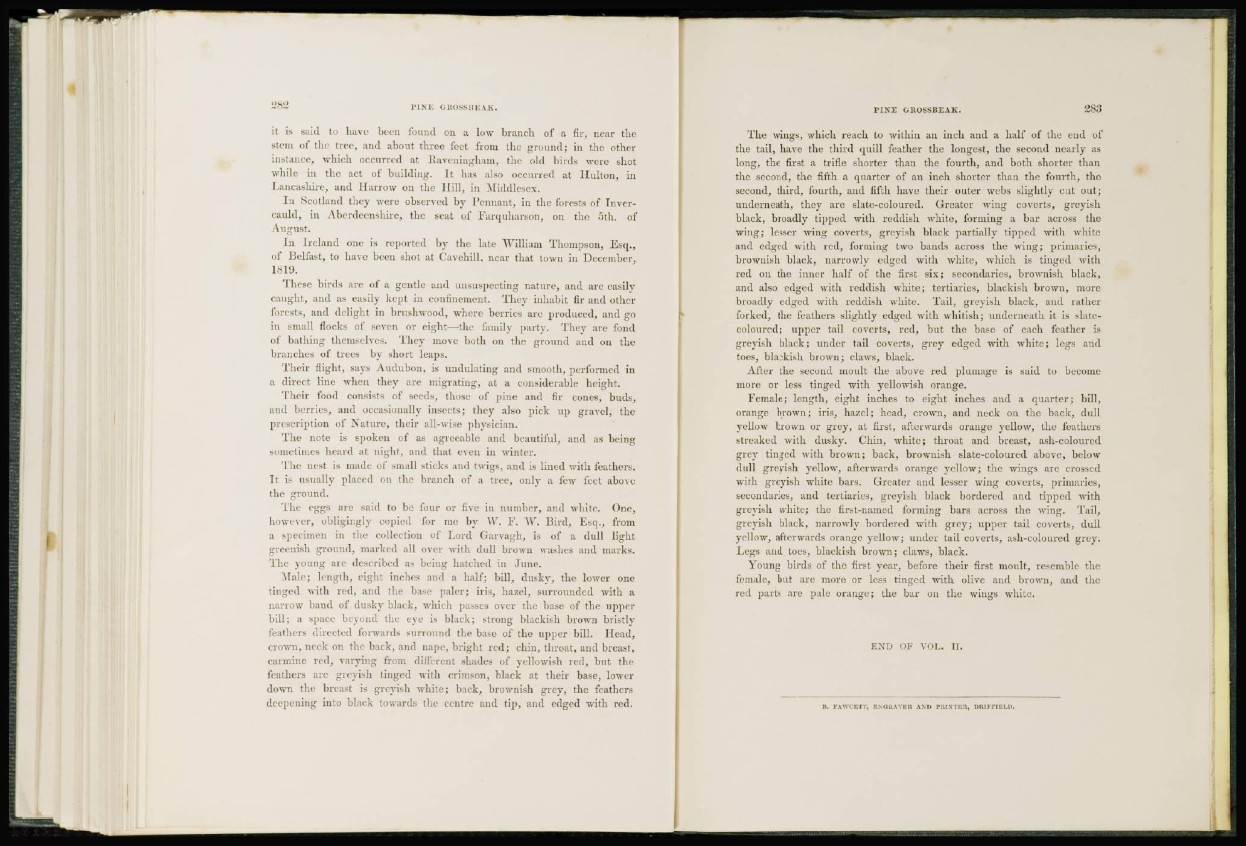
28;> PINE GROSSBE \K.
it is said to have been found on a low brunch of a fir, near the
stem of the tree, and about three feet from the ground; in the other
instance, which occurred at Raveuiugham, the old birds were shot
while in the act of building. It has also occurred at Hulton, in
Lancashire, and Harrow on the Hill, in Middlesex.
Iu Scotland they wore observed by Pennant, in the forests of Tnvercauld,
in Aberdeenshire, the seat of Farquharson, on the 5th. of
August.
In Ireland one is reported by the late William Thompson, Esq.,
of Belfast, to have been shot at Cavehill, near that town in December,
1819.
These birds are of a gentle and unsuspecting nature, and arc easily
caught, and as easily kept iu confinement. They inhabit fir and other
forests, and delight iu brushwood, where berries arc produced, and go
in small flocks of seven or eight—the family party. They are fond
of bathing themselves. They move both on the ground and on the
branches of trees by short leaps.
Their flight, says Audubon, is undulating and smooth, performed in
a direct line when they are migrating, at a considerable height.
Their food consists of seeds, those of pine and fir cones, buds,
and berries, and occasionally insects; they also pick up gravel, the
prescription of Nature, their all-wise physician.
The note is spoken of as agreeable and beautiful, and as being
sometimes heard at night, and that even in winter.
The nest is made of small sticks and twigs, and is lined with feathers.
It is usually placed on the branch of a tree, only a few feet above
the ground.
The eggs are said to be four or five in number, and white. One,
however, obligingly copied for mc by W. F. W. Bird, Esq., from
a specimen in the collection of Lord Garvagh, is of a dull light
greenish ground, marked all over with dull brown washes and marks.
The young ate described as being hatched in June.
Male; length, eight inches and a half; bill, dusky, the lower one
tinged with red, and the base paler; iris, hazel, surrounded with a
narrow band of dusky black, which passes over the base of the upper
bill; a space beyond the eye is black; strong blackish brown bristly
feathers directed forwards surround the base of the iq>pcr bill. Head,
crown, neck on the back, and nape, bright red; chin, throat, and breast,
carmine red, varying from different shades of yellowish red, but the
feathers are greyish tinged with crimson, black at their base, lower
down the breast is greyish white; back, brownish grey, the feathers
deepening into black towards the centre and tip, and edged with red.
TINE GROSSBEAK. £83
The wings, which reach to within an inch and a half of the end of
the tail, have the third quill feather the longest, the second nearly as
long, the first a trifle shorter than the fourth, and both shorter than
the second, the fifth a quarter of an inch shorter than the fourth, the
second, third, fourth, and fifth have their outer webs slightly cut out;
underneath, they are slate-coloured. Greater wing coverts, greyish
black, broadly tipped with reddish white, forming a bar across the
wing; lesser wing coverts, greyish black partially tipped with white
and edged with red, forming two bands across the wing; primaries,
brownish black, narrowly edged with white, which is tinged with
red on the inner half of the first six; secondaries, brownish black,
and also edged with reddish white; tertiaries, blackish brown, more
broadly edged with reddish wdiitc. Tail, greyish black, and rather
forked, the feathers slightly edgetl with whitish; underneath it is slatecoloured;
upper tail coverts, red, but the base of each feather is
greyish black; under tail coverts, grey edged with white; legs and
toes, blackish brown; claws, black.
After the second moult the above red plumage is said to become
more or less tinged with yellowish orange.
Female; length, eight inches to eight inches and a quarter; bill,
orange brown; iris, hazel; head, crown, and neck on the back, dull
yellow brown or grey, at first, afterwards orange yellow, the feathers
streaked with dusky. Chin, white; throat and breast, ash-coloured
grey tinged with brown; back, brownish slate-coloured above, below
dull greyish yellow, afterwards orange yellow; the wings are crossed
with greyish white bars. Greater and lesser wing coverts, primaries,
secondaries, and tertiaries, greyish black bordered and tipped with
greyish white; the first-named forming bars across the wing. Tail,
greyish black, narrowly bordered with grey; upper tail coverts, dull
yellow, afterwards orange yellow; under tail coverts, ash-coloured grey.
Legs and toes, blackish brown; claws, black.
Young birds of the first year, before their first moult, resemble the
female, but are more or less tinged with olive and brown, and the
red parts are pale orange; the bar on the wings white.
END OF VOL. II.
B. FAWCETT, E.NGIl.VVKK AND PRINTER, DRIFFIELD.